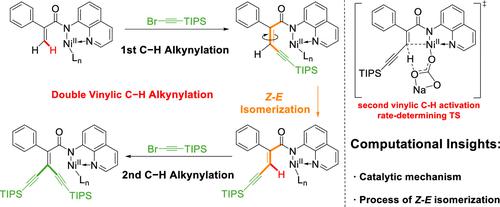当前位置:
X-MOL 学术
›
J. Org. Chem.
›
论文详情
Our official English website, www.x-mol.net, welcomes your feedback! (Note: you will need to create a separate account there.)
Density Functional Theory Study on the Mechanism of Nickel-Catalyzed 3,3-Dialkynylation of 2-Aryl Acrylamides Via Double Vinylic C–H Bond Activation
The Journal of Organic Chemistry ( IF 3.6 ) Pub Date : 2024-04-12 , DOI: 10.1021/acs.joc.3c02987 Ailin Gao 1 , Zhenfeng Shang 1 , Ruifang Li 1 , Xiufang Xu 1
The Journal of Organic Chemistry ( IF 3.6 ) Pub Date : 2024-04-12 , DOI: 10.1021/acs.joc.3c02987 Ailin Gao 1 , Zhenfeng Shang 1 , Ruifang Li 1 , Xiufang Xu 1
Affiliation

|
The mechanisms of Ni-catalyzed 3,3-dialkynylation of 2-aryl acrylamide have been investigated by using density functional theory calculations. The result shows that this reaction includes double alkynylation, which involves sequential key steps of vinylic C–H bond activation, successive oxidative addition, and reductive elimination, with the second C–H bond activation being the rate-determining step. C–H and N–H bond activation occurs via the concerted metalation-deprotonation mechanism. The calculations show that no transition state exists in the first reductive elimination process, and a negative free energy barrier in the second reductive elimination process though a transition state is identified, indicating that the nickel-catalyzed vinylic C(sp2)–C(sp) bond formation does not require activation energy. Z–E isomerization is the prerequisite for the second alkynylation. In addition, our spin-flip TDDFT (SF-TDDFT) computational result discloses that the actual process of Z–E isomerization occurs on the potential energy surface of the first excited singlet state S1.
中文翻译:

镍催化双乙烯基C-H键活化2-芳基丙烯酰胺3,3-二炔化反应机理的密度泛函理论研究
通过密度泛函理论计算研究了 Ni 催化 2-芳基丙烯酰胺 3,3-二炔基化反应的机理。结果表明,该反应包括双炔基化,涉及乙烯基C-H键活化、连续氧化加成和还原消除的连续关键步骤,其中第二次C-H键活化是速率决定步骤。 C-H 和 N-H 键的激活是通过协同金属化-去质子化机制发生的。计算结果表明,在第一次还原消除过程中不存在过渡态,虽然识别出过渡态,但在第二次还原消除过程中存在负自由能垒,这表明镍催化的乙烯基C(sp 2 )–C(sp )键的形成不需要活化能。Z-E异构化是第二次炔基化的前提。此外,我们的自旋翻转TDDFT(SF-TDDFT)计算结果揭示了Z - E异构化的实际过程发生在第一激发单重态S 1的势能面上。
更新日期:2024-04-13
中文翻译:

镍催化双乙烯基C-H键活化2-芳基丙烯酰胺3,3-二炔化反应机理的密度泛函理论研究
通过密度泛函理论计算研究了 Ni 催化 2-芳基丙烯酰胺 3,3-二炔基化反应的机理。结果表明,该反应包括双炔基化,涉及乙烯基C-H键活化、连续氧化加成和还原消除的连续关键步骤,其中第二次C-H键活化是速率决定步骤。 C-H 和 N-H 键的激活是通过协同金属化-去质子化机制发生的。计算结果表明,在第一次还原消除过程中不存在过渡态,虽然识别出过渡态,但在第二次还原消除过程中存在负自由能垒,这表明镍催化的乙烯基C(sp 2 )–C(sp )键的形成不需要活化能。Z-E异构化是第二次炔基化的前提。此外,我们的自旋翻转TDDFT(SF-TDDFT)计算结果揭示了Z - E异构化的实际过程发生在第一激发单重态S 1的势能面上。



























 京公网安备 11010802027423号
京公网安备 11010802027423号